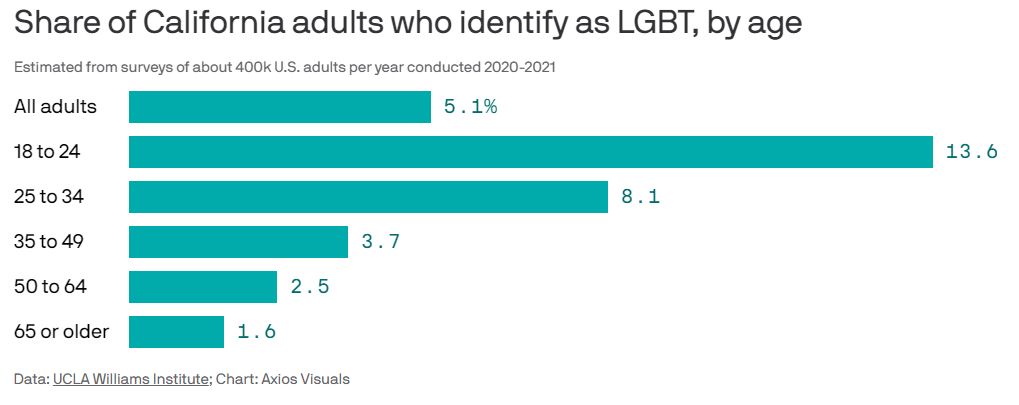Measuring California’s LGBT population
Understanding the LGBTQ+ Population in California : A Crucial Analysis

Data: UCLA Williams Institute; Chart: Axios Visuals
In the diverse and dynamic universe of identities, understanding the size and distribution of the LGBTQ+ population is crucial. Despite challenges posed by data collection methods, recent efforts offer significant insight, particularly in California.
The Californian Context
According to a recent analysis, California has a smaller percentage of adults identifying as LGBT compared to other U.S. states. Specifically, 5.1% of California adults identify as LGBT, a figure slightly lower than the national average of 5.5%. This statistic comes from a specific survey conducted by the Williams Institute, a think tank at UCLA Law, specializing in sexual orientation and gender identity law and public policy issues.
Demographic Disparity
The analysis reveals significant disparities within the state’s population, particularly in terms of age. Among young adults aged 18 to 24, 13.6% identify as LGBT. This percentage gradually decreases with age, highlighting a trend towards greater acceptance and recognition of LGBT identities among younger generations.
Regional Comparisons
Nationally, Washington D.C. and Oregon stand out with the highest rates of adults identifying as LGBT, at 14.3% and 7.8%, respectively. These figures highlight regional variations and the need for nuanced policy approaches to meet the needs of the LGBTQ+ community.
Challenges and Perspectives
Data collection on the LGBTQ+ population is hampered by the lack of specific questions in standardized national surveys. Moreover, self-reported responses can be influenced by factors such as local attitudes and privacy concerns, especially in less welcoming states.
Conclusion
The need for accurate and representative data on the LGBTQ+ population is undeniable. It is essential to inform public policies and ensure adequate care for the health and well-being needs of the community. As Kerith Conron from the Williams Institute points out, the world is evolving, and it is imperative to adapt environments and policies to ensure the well-being and safety of everyone.
FAQ
Q: Why is it important to know the size of the LGBTQ+ population ? A : Understanding the size and distribution of the LGBTQ+ population helps to inform and guide public policies and services to effectively meet their specific needs.
Q: How are data on the LGBTQ+ population collected in California ? A: Data mainly come from specific surveys and studies, such as the Behavioral Risk Factor Surveillance System, which collects health information through telephone surveys.
Q: What are the implications of age disparities in LGBTQ+ identification ? A: Age disparities reflect societal changes and growing acceptance of LGBTQ+ identities among younger people, highlighting the importance of inclusive education and supportive policies.
Q: How do attitudes towards the LGBTQ+ community affect the collected data ? A: Hostile attitudes can deter individuals from identifying as LGBTQ+ in surveys, which may lead to an underestimation of the actual size of the community in certain regions.














+ There are no comments
Add yours